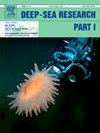深海和深海环境中鳞虫的多样性(拟乳虫目,环节动物)
IF 2.3
3区 地球科学
Q2 OCEANOGRAPHY
Deep-Sea Research Part I-Oceanographic Research Papers
Pub Date : 2025-03-19
DOI:10.1016/j.dsr.2025.104490
引用次数: 0
摘要
深海由各种各样的无脊椎动物群落主导,其中环节动物是最多产的。在这些环节动物中,鳞虫(Aphroditiformia)一直被认为是深海群落的主要组成部分,但它们的总体多样性和分布尚不清楚。为了更好地了解这种多样性,我们对生活在3000米或以下深度的鳞虫进行了首次全面普查。我们对世界海洋物种名录(World Register of Marine species, WoRMS)收录的所有物种进行文献分析,发现418条记录,122种,分布在拟龙科、拟龙科和拟龙科,其中拟龙科种类最多。在蓼科中,有12种被鉴定为赤潮带。讨论了数据集的注意事项。历史的,最近发表的,和新的原位观察的Aphroditiformia在hadal深度也提出。这些结果为今后深海拟阳虫的研究提供了基础。本文章由计算机程序翻译,如有差异,请以英文原文为准。
Scale worm diversity in abyssal and hadal environments (Aphroditiformia, Annelida)
The deep sea is dominated by diverse invertebrate communities, of which annelids are among the most prolific. Within such annelids, scale worms (Aphroditiformia) have long been recognized as a major component to the composition of deep-sea communities, yet their overall diversity and distribution is unknown. To better understand this diversity, we provide the first comprehensive census of scale worms inhabiting depths at or below 3000 m. Our literature analyses across all species recognized by the World Register of Marine Species (WoRMS) revealed 418 records and 122 species spread across Aphroditidae, Polynoidae and Sigalionidae, of which the second was the most species rich. Within Polynoidae, 12 species were identified as hadal zone exclusives. Caveats of the dataset are discussed. Historical, recently published, and new in situ observations of Aphroditiformia at hadal depths are also presented. These results provide a baseline for future investigations across deep sea Aphroditiformia.
求助全文
通过发布文献求助,成功后即可免费获取论文全文。
去求助
来源期刊
CiteScore
4.60
自引率
4.20%
发文量
144
审稿时长
18.3 weeks
期刊介绍:
Deep-Sea Research Part I: Oceanographic Research Papers is devoted to the publication of the results of original scientific research, including theoretical work of evident oceanographic applicability; and the solution of instrumental or methodological problems with evidence of successful use. The journal is distinguished by its interdisciplinary nature and its breadth, covering the geological, physical, chemical and biological aspects of the ocean and its boundaries with the sea floor and the atmosphere. In addition to regular "Research Papers" and "Instruments and Methods" papers, briefer communications may be published as "Notes". Supplemental matter, such as extensive data tables or graphs and multimedia content, may be published as electronic appendices.

 求助内容:
求助内容: 应助结果提醒方式:
应助结果提醒方式:


